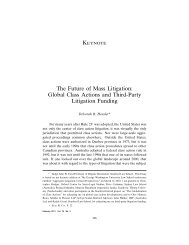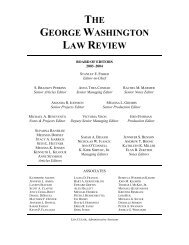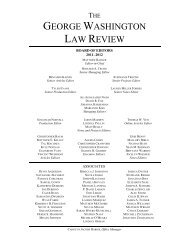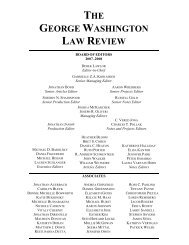View PDF - The George Washington Law Review
View PDF - The George Washington Law Review
View PDF - The George Washington Law Review
You also want an ePaper? Increase the reach of your titles
YUMPU automatically turns print PDFs into web optimized ePapers that Google loves.
890 <strong>The</strong> <strong>George</strong> <strong>Washington</strong> <strong>Law</strong> <strong>Review</strong> [Vol. 78:870<br />
the owner is capable of recovering his original investment and, if not,<br />
whether the regulation is the proximate cause of that inability.<br />
Using a cost-basis recovery approach in regulatory takings inquiries<br />
is a practical option, as evidenced by its application by the Court of<br />
Federal Claims to determine the economic-impact, or diminution-ofvalue,<br />
factor of the Penn Central balancing test. Although the Supreme<br />
Court measures the economic-impact factor as the comparison<br />
of the fair market value of the property in the absence of the regulation<br />
and the fair market value of the property with the regulation, 118<br />
the Court of Federal Claims has analyzed economic impact by comparing<br />
the value of the regulated property with the owner’s original<br />
cost basis. For example, in Walcek v. United States, 119 a takings claim<br />
was rejected even though the Clean Water Act prohibited the development<br />
of wetland property because, despite the diminution in value,<br />
the owners still had the ability to realize a return of “$305,031 over<br />
their total cash outlays.” 120<br />
This Note proposes that the Supreme Court replace Lucas with a<br />
per se rule that adopts the Court of Federal Claims’ cost-basis analysis<br />
to determine regulatory takings claims. Under this approach, if the<br />
regulation proximately causes a reduction in property value so that<br />
the owner is unable to recover his cost basis, a Fifth Amendment taking<br />
has occurred and the property owner is entitled to just<br />
compensation.<br />
B. Measuring Just Compensation<br />
Using this proposed rule, just compensation would be measured<br />
as the difference between the property owner’s original investment<br />
and the value of the property after the regulation’s enactment. For<br />
instance, John purchased the trailer park for $400,000. Assume that<br />
five years pass and the property’s value appreciates to $475,000. <strong>The</strong><br />
regulation banning trailer homes is then enacted and causes the prop-<br />
118 See Gerald A. Fisher, <strong>The</strong> Comprehensive Plan Is an Indispensable Compass for Navigating<br />
Mixed-Use Zoning Decisions Through the Precepts of the Due Process, Takings, and Equal<br />
Protection Clauses, 40 URB. LAW. 831, 877 (2008) (“<strong>The</strong> comparison is expressed as a fraction,<br />
with the regulated value representing the numerator and the unregulated value representing the<br />
denominator. <strong>The</strong> fraction formed in this manner demonstrates the portion of the property’s<br />
value remaining following application of the regulation.”).<br />
119 Walcek v. United States, 49 Fed. Cl. 248 (2001).<br />
120 See id. at 267 (implementing the cost-basis approach to determining a regulation’s economic<br />
impact). <strong>The</strong> Court explained that it would be inappropriate to consider inflation because<br />
there is “no assurance that any investment, let alone an investment in property, will increase in<br />
value in lock-step with inflation.” Id. at 266.









